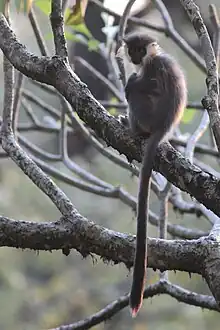Capped langur
The capped langur (Trachypithecus pileatus) is a species of primate in the family Cercopithecidae. It is native to Bangladesh, Bhutan, India, and Myanmar. Its natural habitat is subtropical or tropical dry forests. It is threatened by habitat loss.[1] They are arboreal and gregarious by nature. A herd of capped langurs consists of 2 to 14 langurs led by a single male. They are herbivorous, eating leaves, twigs, buds and fruits.
| Capped langur | |
|---|---|
 | |
| Capped langur in Manas National Park | |
| Scientific classification | |
| Domain: | Eukaryota |
| Kingdom: | Animalia |
| Phylum: | Chordata |
| Class: | Mammalia |
| Order: | Primates |
| Suborder: | Haplorhini |
| Infraorder: | Simiiformes |
| Family: | Cercopithecidae |
| Genus: | Trachypithecus |
| Species: | T. pileatus[2] |
| Binomial name | |
| Trachypithecus pileatus[2] (Blyth, 1843) | |
 | |
| Capped langur range | |
Taxonomy
There are four recognized subspecies:[2]
- Trachypithecus pileatus pileatus
- Trachypithecus pileatus durga
- Trachypithecus pileatus brahma
- Trachypithecus pileatus tenebricus
Behaviour and ecology

Capped Langur in Kaziranga National Park
A study of their diet in winter found that they spend nearly 40% of the day time feeding on leaves, flowers and fruits. Leaves contributed nearly 60% of the diet and they foraged on as many as 43 different plant species.[3]
References
- Das, J.; Chetry, D.; Choudhury, A. & Bleisch, W. (2020). "Trachypithecus pileatus". IUCN Red List of Threatened Species. 2020: e.T22041A196580469. doi:10.2305/IUCN.UK.2020-3.RLTS.T22041A196580469.en. Retrieved 17 January 2022.
- Groves, C. P. (2005). "Species Trachypithecus pileatus". In Wilson, D. E.; Reeder, D. M. (eds.). Mammal Species of the World: A Taxonomic and Geographic Reference (3rd ed.). Baltimore: Johns Hopkins University Press. p. 177. ISBN 0-801-88221-4. OCLC 62265494.
- Solanki, G.S.; Kumar, A & Sharma, B.K. (2008). "Winter food selection and diet composition of capped langur (Trachypithecus pileatus) in Arunachal Pradesh, India". Tropical Ecology. 49 (2): 157–166.
This article is issued from Wikipedia. The text is licensed under Creative Commons - Attribution - Sharealike. Additional terms may apply for the media files.
